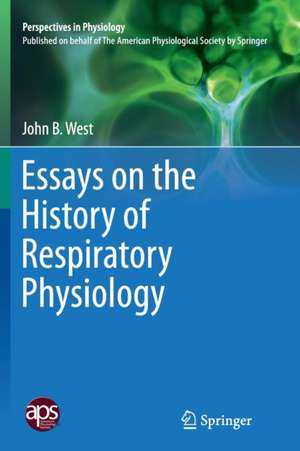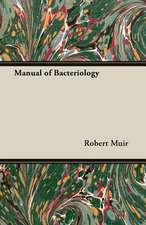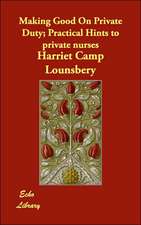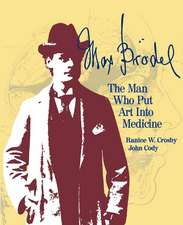Essays on the History of Respiratory Physiology: Perspectives in Physiology
Autor John B. Westen Limba Engleză Paperback – 5 oct 2016
This book is published on behalf of the American Physiological Society by Springer. Access to APS books published with Springer is free to APS members.
| Toate formatele și edițiile | Preț | Express |
|---|---|---|
| Paperback (1) | 1160.63 lei 6-8 săpt. | |
| Springer – 5 oct 2016 | 1160.63 lei 6-8 săpt. | |
| Hardback (1) | 1167.78 lei 6-8 săpt. | |
| Springer – 31 ian 2015 | 1167.78 lei 6-8 săpt. |
Preț: 1160.63 lei
Preț vechi: 1221.72 lei
-5% Nou
Puncte Express: 1741
Preț estimativ în valută:
222.09€ • 232.46$ • 184.85£
222.09€ • 232.46$ • 184.85£
Carte tipărită la comandă
Livrare economică 31 martie-14 aprilie
Preluare comenzi: 021 569.72.76
Specificații
ISBN-13: 9781493949779
ISBN-10: 1493949772
Pagini: 356
Ilustrații: XIV, 342 p. 129 illus., 14 illus. in color.
Dimensiuni: 155 x 235 x 19 mm
Greutate: 0.5 kg
Ediția:Softcover reprint of the original 1st ed. 2015
Editura: Springer
Colecția Springer
Seria Perspectives in Physiology
Locul publicării:New York, NY, United States
ISBN-10: 1493949772
Pagini: 356
Ilustrații: XIV, 342 p. 129 illus., 14 illus. in color.
Dimensiuni: 155 x 235 x 19 mm
Greutate: 0.5 kg
Ediția:Softcover reprint of the original 1st ed. 2015
Editura: Springer
Colecția Springer
Seria Perspectives in Physiology
Locul publicării:New York, NY, United States
Cuprins
Galen and the beginnings of Western physiology.- Ibn al-Nafis, the pulmonary circulation, and the Islamic Golden Age.- Torricelli and the ocean of air: the first measurement of barometric pressure.- Robert Boyle’s landmark book of 1660 with the first experiments on rarified air.- The original presentation of Boyle's Law.- Robert Hooke: Early respiratory physiologist, polymath, and mechanical genius.- Marcello Malpighi and the discovery of the pulmonary capillaries and alveoli.- Stephen Hales: neglected respiratory physiologist.- Joseph Black, carbon dioxide, latent heat, and the beginnings of the discovery of the respiratory gases.- Carl Wilhelm Scheele, the discoverer of oxygen, and a very productive chemist.- Joseph Priestley, oxygen, and the Enlightenment.- The collaboration of Antoine and Marie-Anne Lavoisier and the first measurements of human oxygen consumption.- Henry Cavendish, hydrogen, water, and the weight of the earth.- Humphry Davy, nitrous oxide, the Pneumatic Institution, and the Royal Institution.- Denis Jourdanet (1815-1892) and the early recognition of the role of hypoxia at high altitude.- Centenary of the Anglo-American High Altitude Expedition to Pikes Peak.- Alexander M. Kellas and the physiological challenge of Mount Everest.- Ravenhill and his contributions to mountain sickness.- George I. Finch and his pioneering use of oxygen for climbing at extreme altitudes.- Joseph Barcroft's studies of high altitude physiology.- The physiological legacy of the Fenn, Rahn and Otis school.- The physiological challenges of the 1952 Copenhagen poliomyelitis epidemic and a renaissance in clinical respiratory physiology.- Historical aspects of the early Soviet/Russian manned space program.
Textul de pe ultima copertă
This book consists of 23 essays about prominent people and events in the history of respiratory physiology. It provides a first-hand chronicle of the advancements made in respiratory physiology starting with Galen and the beginnings of Western physiology. The volume covers many aspects of the evolution of this important area of knowledge: pulmonary circulation, Boyle’s Law, pulmonary capillaries and alveoli, morphology, gas exchange and blood flow, mechanics, control of ventilation, and comparative physiology. The book emphasizes societal and philosophical aspects of the history of science. Although it concentrates on physiology, it also describes how cultural movements, such as The Enlightenment, shaped the researchers discussed.
Caracteristici
The book is written for scientists but is accessible to interested non-scientists Covers the history of significant people and events over the whole course of respiratory physiology Discusses how historical events such as the Renaissance and Enlightenment shaped respiratory physiology Includes supplementary material: sn.pub/extras























![Medical Practice in Twelfth-century China – A Translation of Xu Shuwei’s Ninety Discussions [Cases] on Cold Damage Disorders](https://i2.books-express.ro/bt/9783030061029/medical-practice-in-twelfth-century-china-a-translation-of-xu-shuwei-s-ninety-discussions-cases-on-cold-damage-disorders.jpg)





